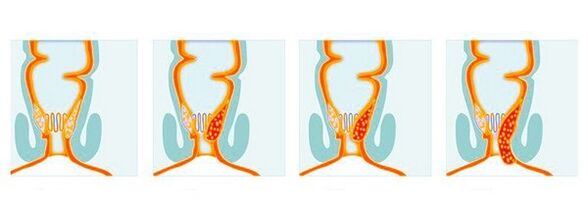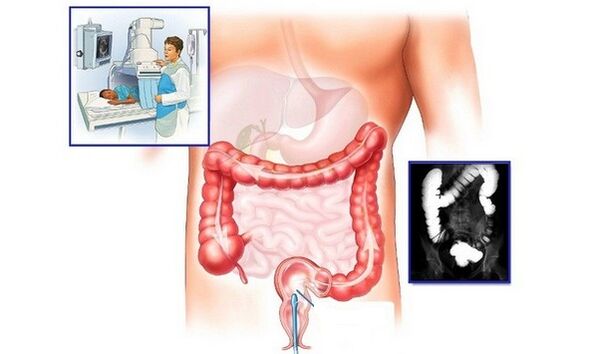
Hemorrhoids are a condition in which blood stagnates and there are abnormal changes in the veins of the rectum or in the area around the anus. Such a delicate pathology has no restrictions on age and gender.
The fundamental factor leading to the formation of hemorrhoidal cones is stagnation, which, in turn, arises from a large number of other pathogenic factors.
Pathology is characterized by characteristic symptoms that a person cannot ignore. The most specific clinical signs of hemorrhoids are itching and burning in the anal area, rectal bleeding, and severe pain around the anus.
The clinician should be able to make an accurate diagnosis on the basis of a physical exam, but in addition, some laboratory and instrumental tests may be needed.
Direct treatment of hemorrhoids depends on the severity of the disease, which is why it can be both conservative and surgical.
Since pathology has a wide variety, it is coded with several meanings in the International Classification of Diseases.
Etiology
The main reasons for the appearance of hemorrhoid cones are:
- violation of the operation of the circuits of this organ;
- increased arterial blood flow;
- disturbances in the flow of blood from the venous plexus;
- loss of tone of the veins of the rectum, which leads to their enlargement and the appearance of nodes.
In addition, clinicians identify a large number of adverse factors that lead to the above processes, which is why they are often divided into several groups - pathological and physiological.
The first type of causes of hemorrhoids include:
- chronic constipation - hard stools that damage the walls of the rectum and anus;
- severe intoxication of the body - this includes poisoning with alcoholic beverages, toxic and chemical substances, as well as low-quality food;
- profuse diarrhea of an infectious nature;
- the formation of malignant, less often benign tumors in the intestine;
- diseases of the pelvic organs, such as prostatitis or cystitis;
- inflammatory diseases of the digestive system;
- Hormonal disorder;
- portal hypertension and cirrhosis, as well as other diseases of this organ. The connection of hemorrhoids to the liver is due to the presence of common veins;
- Pathological effects of pathogenic bacteria lead to the development of infection.
In addition to diseases and disorders, the cause of hemorrhoids may not be related to the presence of one or another disease in the body. Among the physiological factors, it is worth highlighting:
- lack of physical activity - this happens against the background of various sources - laziness, a serious illness that incapacitates the patient's mobility, as well as specific working conditions to which a person is forcedhaving to sit or stand most of the time;
- excess body weight;
- poor nutrition - including overuse of fatty, spicy foods, smoked meats, confectionery, carbonated drinks, semi-finished products, fast foods and other harmful ingredients. It is for that reason that diet therapy is one of the factors that make up the process of treating hemorrhoids;
- indiscriminate use of drugs, including laxatives or birth control pills;
- incorrect implementation of proctological or enema diagnostic procedures;
- unusual sexual preferences, namely anal sex;
- lasting effects of stressful situations;
- performing heavy physical activities;
- participating in certain sports, in particular, cycling or cycling, equestrian sports and other types of weight lifting;
- excessive drinking and smoking;
- childbirth or labor period;
- menstruation.
Genetic predisposition plays an important role in the development of the disease. Diagnosis of a similar pathology in one of the closest relatives significantly increases the likelihood of a collision. Knowing this, you can independently prevent the occurrence of the disease, you just need to follow all the rules for the prevention of hemorrhoids.
Classify
By its clinical nature, the disease is:
- acute - this is the first manifestation of hemorrhoids that have not been diagnosed before;
- chronic - is characterized by alternating periods of exacerbation of symptoms and their remission.
Depending on the area of formation of hemorrhoids, cavernous pathology is divided into:
- External hemorrhoids - is so if the tumor appears under the skin of the anus, and not under the mucous membrane of the rectum. It is considered the rarest form of the disease;
- Internal hemorrhoids are the most common pathology, in which there is the appearance of cones directly in the anal canal;
- Mixed hemorrhoids - the second most common type of disease, which is characterized by the appearance of signs of the two forms described above.
In addition, there are other types of hemorrhoids, divided by severity:
- mild course - symptoms may be completely absent or present to a negligible degree. Conservative methods prevail in therapy;
- moderate - severe - differs in that there is additional pain due to the enlargement of nodes and their damage caused by stool. The internal bumps fall off during defecation, after which they correct themselves. The disease can be eliminated by minimally invasive methods;
- severe - is characterized by the manifestation of such a sign of hemorrhoids as bleeding. Nodes can fall out not only during bowel movements but also in any other situation leading to increased intra-abdominal pressure. In such cases, they can only be adjusted manually. Strategies for how to remove hemorrhoids can include both minimally invasive procedures and extensive operations;
- complex - is represented by an increase in the symptoms of the disease, and during the diagnosis, the development of complications is often observed, one of which may be thrombosis. However, it should be noted that not every case that does not treat hemorrhoids in time has consequences.

Symptom
The first signs of hemorrhoids can be so subtle that they go unnoticed. The initial clinical manifestations are considered to be:
- slight discomfort in the anus;
- non-severe itching of the anal area;
- pain during bowel movements;
- swelling at the entrance to the anal canal.
As the disease progresses, the following symptoms of hemorrhoids will begin to appear:
- severe and burning itching;
- increased pain, which occurs not only during bowel movements, but also when walking with intensity or sitting for a long time;
- the appearance of impurities of blood and mucus in the stool. It is noteworthy that pathological blood clots will not mix with the stool, but lie on it;
- prolapsed hemorrhoids, resulting in severe pain;
- redness of the skin around the anus;
- rectal bleeding - if in the early stages the sign of hemorrhoids can only manifest as blood on toilet paper or underwear, with a complicated course the bleeding can reach the intensity of a stream. This is what often causes a person to seek help.
In addition to specific clinical manifestations, the above symptoms of hemorrhoids can be supplemented by an increase in body temperature, which indicates the progression of the inflammatory process.
Diagnose
It often happens that when the symptoms of the disease occur, a person does not know which doctor to contact for treatment of hemorrhoids. A specialist or surgeon is involved in diagnosing and treating hemorrhoids, but for an initial consultation, you can contact a specialist. It should be noted that if the child has these signs, it is necessary to immediately take them to a pediatrician, and if a woman is pregnant, she must first consult an obstetrician-gynecologist.
The first phase of diagnosis includes the work of the clinician, which aims to:
- a detailed survey of the patient at the first appearance of signs of hemorrhoids - to determine the stage of the disease process;
- get acquainted with the medical history and life history of not only the patient, but also their relatives - often this is enough to determine the origin of why hemorrhoids appear;
- perform an objective examination to assess the condition of the perianal region, as well as a digital examination of the rectum, to help differentiate internal from external hemorrhoids and determine the localization of the lump.
The second stage to confirm the correct diagnosis is laboratory examination, namely general blood tests, biochemistry and coagulation.
The final part of the diagnosis is an instrumental examination of the patient, which aims to assess what the hemorrhoids look like and to provide:
- sigmoidoscopy;
- Endoscopic;
- colonoscopy;
- X-ray using contrast agent;
- Ultrasound of abdominal organs.

Only after studying the results of the examination, the doctor will come up with a strategy to treat hemorrhoids for the patient.
The treatment
The treatment regimen will depend on the extent of the disease, but common hemorrhoid treatments include:
- the use of drugs for both local and general effects. In the first case, rectal suppositories, ointments, creams and gels are used, and in the second - tablets to improve blood circulation, strengthen veins and neutralize concomitant symptoms;
- adhere to a frugal diet - applied to both external and internal hemorrhoids. All menu recommendations and cooking methods are provided by the attending physician;
- minimally invasive technique to remove hemorrhoids;
- open surgery;
- the use of alternative drug formulations. This should include the preparation of candles and ointments from natural ingredients at home, as well as decoctions from medicinal herbs and plants, which are used for oral administration or as topical bacteria and baths.
Among the minimally invasive methods of treating hemorrhoids, it is worth noting:
- the introduction of the sclerotia directly into the node;
- tied with a rubber ring;
- infrared and condenser;
- coldness;
- incarnation process.
The tactics of hemorrhoid removal will be determined by the stage of the pathology.
With the ineffectiveness of conservative methods, as well as in case of complicated disease progression, open surgery is indicated - hemorrhoidectomy.
How to treat hemorrhoids in pregnant women and children will be guided by obstetricians, gynecologists and pediatricians.
Possible complications
Ignoring obvious clinical phenomena and late treatment of hemorrhoids often leads to the development of the following consequences:
- join secondary infection;
- the spread of the inflammatory process;
- anal sphincter failure;
- heavy bleeding leading to anemia;
- proctitis and paraproctitis;
- the formation of blood clots;
- anal fistula.
Prevention and prognosis
To prevent the appearance of hemorrhoids, the following rules of prevention must be observed:
- have a healthy and moderate lifestyle;
- eat properly and in balance;
- strengthen the pelvic and abdominal muscles;
- take medication only as directed by your doctor;
- if possible, avoid physical and emotional stress;
- promptly deal with constipation and other pathological causes of hemorrhoids;
- ensure that body weight is within normal limits;
- undergo a comprehensive health check on a regular basis.
It is not possible to unequivocally answer the question of hemorrhoid prognosis, as the outcome depends on several factors - the stage and form of the disease, the type of age, when to start hemorrhoid treatment, and the compliance of the disease. core. all clinician recommendations.
Often people who have been diagnosed with hemorrhoids will ask if it can go away on its own. The answer of the doctors will always be negative - the disease will turn into a chronic form.


























